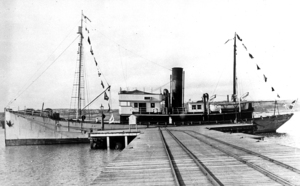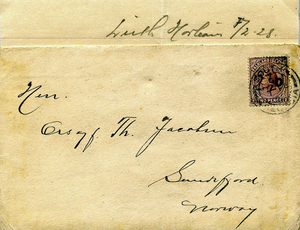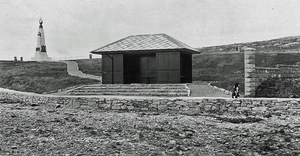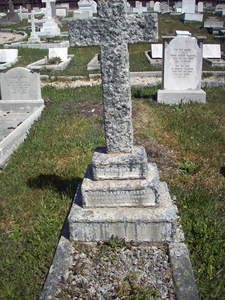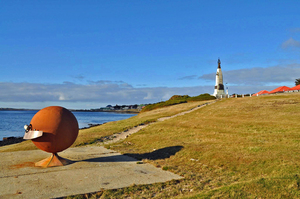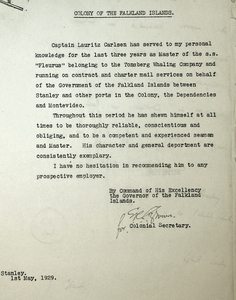CARLSEN, LAURITZ
1875-1931 from Norway
master mariner, and the captain of the Fleurus, which was chartered by the Falkland Islands Government from the Norwegian whaling company A/S Tønsbergs Hvalfangeri in 1924, to carry mail and to aid inter island communication.
Captain Lauritz Carlsen was born in the Norwegian whaling port of Larvik on 25May 1875, the son of Carl Anton Hansen and Anna Sofie Martinsdatter, both born in 1851. In those days it was commonplace in Norway to take one’s surname after the father’s first name, hence his surname became Carlsen.
Little is known about Carlsen’s early life. However, in 1910 a Norwegian census described him as working as a second ship’s officer at South Georgia. He was married, on 05 January 1901, to Gunhilda (Hilda) Sofie Andersen, (born 10 May 1874). They had one child Anne (born 05 November 1909).
In the Spring of 1915 Carlsen was appointed master of the steamship Ocean owned by the whaling company Hvalfangerselskapet Ocean, managed by Chr. Nielsen & Co., Larvik. The vessel provided passage for personnel, whaling crews and cargo to and from the company’s whaling station located at New Fortuna Bay in South Georgia. Many of these homeward voyages were made via Liverpool, where valuable cargoes of whale oil, important for the war-time production of munitions, were discharged. He continued to serve in this capacity until the vessel was sold to other Norwegian interests in October 1917. In 1917 he was also appointed co-chairman for a maritime inquiry which reported on the loss of the Norwegian whale factory ship Falkland which had been sunk on 12 August 1917 by a German U-boat in the North Atlantic.
Carlsen was first appointed master of the Fleurus in the Autumn of 1925, succeeding Captain Nygaard. Fleurus, 406 gross tons, was a former steam escort trawler which had been built in Savannah, USA in 1919 for the French Navy. Fleurus was chartered by the Falkland Islands Government from the Norwegian whaling company A/S Tønsbergs Hvalfangeri, in 1924, to carry mail and for inter-island communication. Carlsen was probably the captain of the Fleurus when Edwardr O'BRIEN travelled down to the South Shetland Islands to investigate the state of the wahle stocks.
Fleurus inaugurated the Government mail service between Stanley, Montevideo and South Georgia (also the other Dependencies) in December 1924. The ship carried mail, passengers and cargo in Government service from 1924 until 1933, when she was replaced by SS Lafonia. During World War II the Fleurus served as a minesweeper with the Royal Norwegian Navy and renamed Thorodd. In March 1941 she was taken into the Royal Navy and named HMS Thorodd (and manned by a Norwegian crew) operating as a minesweeper from Dundee, Scotland. In 1952 she was converted back into a fishing vessel, and she sank off Norway in 1955. During her service in the Falklands, it became possible for the public to book passages on the ship, the vessel later became dubbed ‘the first Antarctic cruise ship’.
In October 1924 the Falkland Islands Magazine and Church Paper advertised commercial fares on the Fleurus, for a maximum of eight passengers - a single voyage to South Georgia or the South Shetland costing £6 and a return voyage at a cost of £10. The chartering and commercial use of the Fleurus was one of many innovations introduced by Governor MIDDLETON. Carlsen’s role as captain of the Fleurus gained him widespread respect and admiration.
The Norwegian Press commented on 10 April 1924 that:
With this service South Georgia will, of course, come into quite good communication considering the conditions, with the outer world. Moreover, there will be excellent opportunities to obtain fresh meat and mails for the expeditions [i.e. the whaling fleets] there.
Carlsen served as the captain of the Fleurus intermittently from 1925 until his death in Stanley on 9 April 1931. During this period, he made many voyages around the Falklands and to South Georgia, the South Shetland Islands, the South Orkney Islands and the Antarctic archipelago, occasionally hosting governmental officers including Governor HODSON – who made two voyages in the Fleurus. The first was in August 1927, when Hodson visited South Georgia, when Captain Adamsen was master. Hodson’s second voyage in the Fleurus, when Lauritz Carlsen was master, was much longer. Between 2 February and 2 March 1928, the Fleurus visited the South Shetland Islands (including Deception Island), the South Orkney Islands, the Antarctic archipelago, and South Georgia.
Hodson was the first Governor to make such a trip, and his lengthy dispatches about his 1928 tour show him to have been adventurous, individualistic and highly opinionated. The prime motive for the trip was to enable the Governor to unveil the recently completed gravestone of Sir Ernest Shackleton at Grytviken. Hodson was an accomplished cartographer and geographer, and his dispatches contain meticulously drawn charts and diagrams.
Hodson thought very highly of Carlsen’s seamanship skills. During the voyage the Fleurus encountered large icebergs near Elephant Island, and he recounted that:
There were enormous bergs miles in length, then smaller ones ranging from twenty yards to a quarter of a mile in diameter. Round these were yet smaller blocks and so on. In between the bergs were narrow strips of water. The whole mass kept on moving slowly northward drive by the gale and probably the following current. Amedroz and myself both thought it would have been wiser to turn back at once and travel around the northern side of Elephant Island. But Captain Carlsen decided to do otherwise. The result was we soon got surrounded by the ice on the edge of the pack. We still went on wending our way through it, made extremely difficult by the gale which was blowing. Soon it appeared as if we were completely surrounded by the floe. There was just one narrow passage which was gradually getting smaller and smaller. The skipper decided to rush through it. It was one of the most exciting things I have ever witnessed. There was just room and only just as we went through, I could have touched the left-hand side with a polo stick if I had one in my hand. It was a superb piece of seamanship and could only have been successfully carried out by a man of iron nerve. It seemed to me to be risky because a small steamer like the Fleurus if she got hit on the side by a berg would go to the bottom. Having passed through this channel we came to the open sea once more and travelled along the edge of the pack, but we kept on finding long narrow arms jutting out through which we had to wend our way. Night came and we hove-to, and then proceeded on our course in the morning. Our skipper [Carlsen] did not sleep a wink all the time and everyone’s nerves got strung up to the highest pitch. We kept on meeting ice all the whole way to the Orkneys, which we reached on February 17th.
Carlsen also briefly took command of whale catchers, delivering several ‘Busen’ boats from the builder’s yard in Norway to South Georgia, but not acting as the ship’s gunner.
Captain Carlsen was very well respected in Norwegian whaling circles, and in the Falklands - both in the community and by the government. On 10 April 1931 the Penguin – the local newspaper in Stanley – reported:
Yesterday’s tragic discovery – the death of Captain Carlsen … It is with deep regret we report the death of Captain Lauritz Carlsen, aged 55 years, master of the SS Fleurus, who was found dead [from a heart attack] near the War Memorial Shelter [1914 Battle of the Falklands Memorial], by the Very Reverend the Dean, and Captain Carl Kurcheiss [sic Kircheiss], who with Mrs Vaughan, were returning home after lunching with His Excellency, the Acting Governor [John ELLIS]… Captain Carlsen had also been expected at Sulivan House for lunch, just before 1.0 o’clock , the Captain having left Ross Road to make his way along the side walk which led to the shelter on the other side of the War Memorial. Only a few minutes earlier he had paid a visit to the Secretariat when he seemed in his usual health … The bad news came as a terrible shock to everyone in the town with whom Captain Carlsen was a familiar figure, and in whose estimation, both a gentleman and a seaman of sterling qualities, he held a foremost place … The captain was also a popular and familiar figure among the islands and stations of the West Falklands where he navigated his ship though the dangerous channels with consummate skill
The funeral of Carlsen took place in Christ Church Cathedral and the building was full to capacity. There were more than 70 floral tributes. On the day of the funeral the Penguin newspaper reported that:
All over the town, and on every ship in the harbour, flags were flown at half-mast, whilst in the house along the route to the cemetery, blinds were drawn as a last token of respect to a gallant and fearless gentleman whose quiet and simple nature had so endeared him to all who were privileged to know him and whose passing is to be deeply deplored.
A fellow Norwegian seaman paid tribute to his fellow countryman:
His steady and fearless performance of his duty, combined with that sense of responsibility which prevented him from endangering, unnecessarily, the ship and the lives under his care, won the respect and admiration of us all. Unfailingly courteous and obliging … He was one of Nature’s gentlemen.
Lauritz Carlsen was buried in Stanley cemetery on 12April 1931.
Editorial comment:
1. Captain Carl Kircheiss (mentioned in the Penguin newspaper’s report of Carlsen’s death) was a pioneer in the development of modern whaling in Germany in the 1930s, and in the 1930/31 season worked onboard A/S Tønsbergs Hvalfangeri's whale catcher Busen 4 "to learn the trade". He was not captain/gunner on board, he was only watching and learning the skills necessary for successful whaler. Whaling at Husvik ended early the 1930/31 season.
2. Where the Memorial shelter once stood, the local artist Rob Yssel, has erected the Solar System sculpture - a 1:1 billion scale model of the solar system.
Comments
Revisions
April 2022 Biography first added to Dictionary
August 2022 One additional image added
April 2023 Text amended
